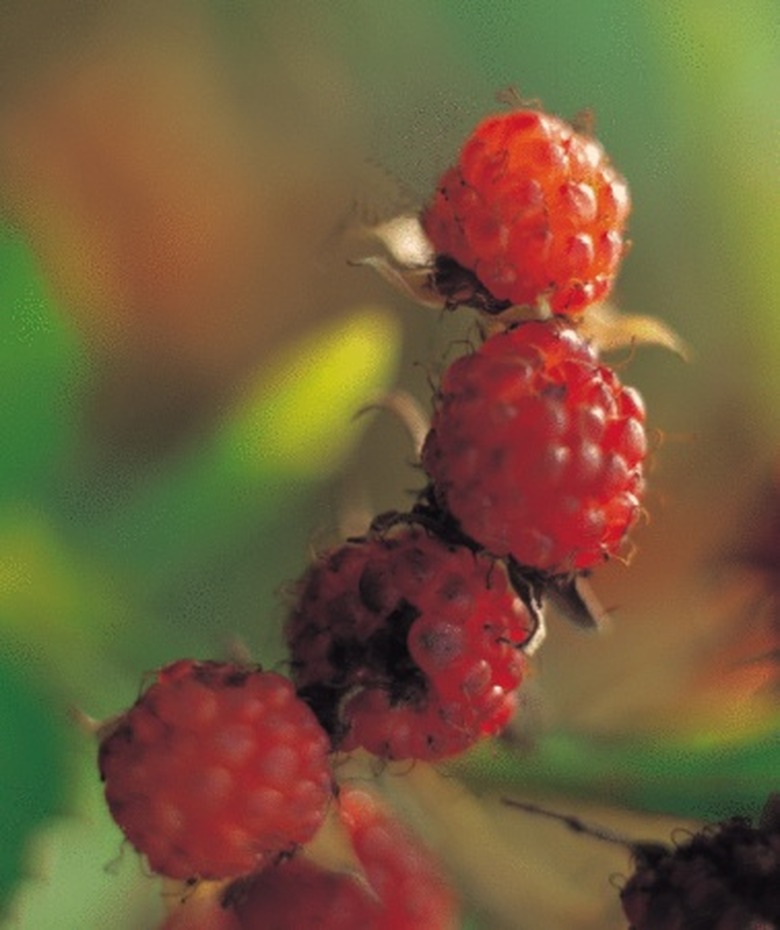Do Raspberries Grow On A Vine?
Raspberries are a valuable but labor-intensive crop that, when well-maintained, can produce fruit for up to 20 years after planting. Many growers use trellises to keep plant stems off the ground. This, in turn, keeps most the fruit off the ground. It also enhances light penetration and distribution throughout the plant. Generally, fruit grown in this way is cleaner and easier to harvest. Pesticide application is also less intensive and more complete. While plants supported by trellises may look like vines, they are actually bushes. In fact, all raspberries grow on bushes.
- Raspberries are a valuable but labor-intensive crop that, when well-maintained, can produce fruit for up to 20 years after planting.
- This, in turn, keeps most the fruit off the ground.
Plant Description
Even without fruit, raspberry plants have certain characteristics that make them readily identifiable. Raspberry leaves are compound, alternate, have serrated margins and are typically wider than those of blackberry plants. The undersides of leaves are slightly fuzzy. New stems, called canes, have a whitish color, waxy texture and small thorns. Crowns and roots of raspberries are perennial, and last the life of the plant, but individual canes only live for two years. Every spring, new canes are formed from crown buds or underground lateral stems to replace dead canes.
Fruit
Although raspberry plants are typically associated with red berries, the berries may also be yellow, purple or black. Raspberries are very similar to blackberries, except that the core remains on the plant when harvested, leaving a hole on the bottom of the plant. This causes the fruit to be hollow like a thimble. Raspberries become ripe in the early summer through the fall. Only ripe berries should be harvested, since they do not continue to ripen after picking.
- Even without fruit, raspberry plants have certain characteristics that make them readily identifiable.
- Raspberries are very similar to blackberries, except that the core remains on the plant when harvested, leaving a hole on the bottom of the plant.
Plant Classifications
Raspberry bushes are often classified by fruit color. Red berries are the most common and widely adaptable variety. They also tend to ripen the earliest and produce the largest berries of the all the raspberry plants. Alternatively, raspberry plants can be classified by blooming tendency, which is divided into summer-bearing plants that bloom once a year during the summer, and everbearing plants bloom once in the spring and once in the fall. Most everbearing raspberries produce red or yellow fruit.
Growing Conditions
Raspberry bushes that are located properly have the most success in fruit production. Raspberries require six to eight hours a day of full sunlight and well-drained soil with a pH between 5.6 and 6.5. Plants prefer sandy loam soil amended with a high degree of organic matter. To reduce the potential spread of viruses, destroy all wild raspberry or blackberry plants within 600 feet of cultivated raspberries. Do not plant in the same location as plants that carry verticillium. This includes potatoes, tomatoes, peppers or eggplants. To be safe, wait at least four years before planting raspberries in a location where any of these plants was previously planted.
- Raspberry bushes are often classified by fruit color.
- To reduce the potential spread of viruses, destroy all wild raspberry or blackberry plants within 600 feet of cultivated raspberries.
References
- University of Illinois Extension: About Raspberries
- University of Florida; Florida Plant Identification; Raspberry (Rubus spp.); July 2009
- Ohio State University Extension Fact Sheet; Raspberries for the Backyard Fruit Planting; Gary Gao
- The University of Maine; Growing Raspberries and Blackberries; David T. Handley; 2006
